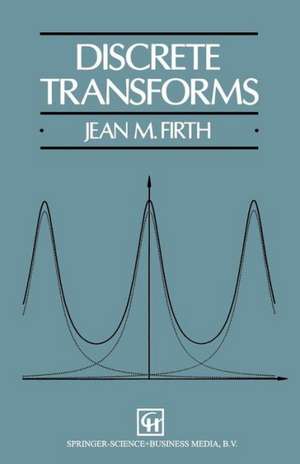Discrete Transforms
Autor J.M. Firthen Limba Engleză Paperback – 30 apr 1992
Preț: 380.45 lei
Nou
Puncte Express: 571
Preț estimativ în valută:
72.82€ • 75.73$ • 61.02£
72.82€ • 75.73$ • 61.02£
Carte tipărită la comandă
Livrare economică 13-27 martie
Preluare comenzi: 021 569.72.76
Specificații
ISBN-13: 9780412429903
ISBN-10: 041242990X
Pagini: 187
Ilustrații: 187 p.
Dimensiuni: 140 x 216 x 11 mm
Greutate: 0.24 kg
Ediția:Softcover reprint of the original 1st ed. 1992
Editura: SPRINGER NETHERLANDS
Colecția Springer
Locul publicării:Dordrecht, Netherlands
ISBN-10: 041242990X
Pagini: 187
Ilustrații: 187 p.
Dimensiuni: 140 x 216 x 11 mm
Greutate: 0.24 kg
Ediția:Softcover reprint of the original 1st ed. 1992
Editura: SPRINGER NETHERLANDS
Colecția Springer
Locul publicării:Dordrecht, Netherlands
Public țintă
ResearchCuprins
1 Fourier series, integral theorem, and transforms: a review.- 1.1 Fourier series.- 1.2 Fourier exponential series.- 1.3 The Fourier integral theorem.- 1.4 Odd and even functions.- 1.5 The Fourier transform.- 1.6 The Fourier sine and cosine transforms.- 1.7 The Laplace transform.- 1.8 Laplace transform properties and pairs.- 1.9 Transfer functions and convolution.- Summary.- Problems.- 2 The Fourier transform. Convolution of analogue signals.- 2.1 Duality.- 2.2 Further properties of the Fourier transform.- 2.3 Comparison with the Laplace transform, and the existence of the Fourier transform.- 2.4 Transforming using a limit process.- 2.5 Transformation and inversion using duality and other properties.- 2.6 Some frequently occurring functions and their transforms.- 2.7 Further Fourier transform pairs.- 2.8 Graphical aspects of convolution.- Summary.- Problems.- 3 Discrete signals and transforms. The Z-transform and discrete convolution.- 3.1 Sampling, quantization and encoding.- 3.2 Sampling and ‘ideal’ sampling models.- 3.3 The Fourier transform of a sampled function.- 3.4 The spectrum of an ‘ideally sampled’ function.- 3.5 Aliasing.- 3.6 Transform and inversion sums; truncation.- 3.7 Windowing: band-limited signals and signal energy.- 3.8 The Laplace transform of a sampled signal.- 3.9 The Z-transform.- 3.10 Input-output systems and transfer functions.- 3.11 Properties of the Z-transform.- 3.12 Z-transform pairs.- 3.13 Inversion.- 3.14 Discrete convolution.- Summary.- Problems.- 4 Difference equations and the Z-transforms.- 4.1 Forward and backward difference operators.- 4.2 The approximation of a differential equation.- 4.3 Ladder networks.- 4.4 Bending in beams: trial methods of solution.- 4.5 Transforming a second-order forward difference equation.- 4.6 Thecharacteristic polynomial and the terms to be inverted.- 4.7 The case when the characteristic polynomial has real roots.- 4.8 The case when the characteristic polynomial has complex roots.- 4.9 The case when the characteristic equation has repeated roots.- 4.10 Difference equations of order N > 2.- 4.11 A backward difference equation.- 4.12 A second-order equation: comparison of the two methods.- Summary.- Problems.- 5 The discrete Fourier transform.- 5.1 Approximating the exponential Fourier series.- 5.2 Definition of the discrete Fourier transform.- 5.3 Establishing the inverse.- 5.4 Inversion by conjugation.- 5.5 Properties of the discrete Fourier transform.- 5.6 Discrete correlation.- 5.7 Parseval’s theorem.- 5.8 A note on sampling in the frequency domain, and a further comment on window functions.- 5.9 Computational effort and the discrete Fourier transform.- Summary.- Problems.- 6 Simplification and factorization of the discrete Fourier transform matrix.- 6.1 The coefficient matrix for an eight-point discrete Fourier transform.- 6.2 The permutation matrix and bit-reversal.- 6.3 The output from four two-point discrete Fourier transforms.- 6.4 The output from two four-point discrete Fourier transforms.- 6.5 The output from an eight-point discrete Fourier transform.- 6.6 ‘Butterfly’ calculations.- 6.7 ‘Twiddle’ factors.- 6.8 Economies.- Summary.- Problems.- 7 Fast Fourier transforms.- 7.1 Fast Fourier transform algorithms.- 7.2 Decimation in time for an eight-point discrete Fourier transform: first stage.- 7.3 The second stage: further periodic aspects.- 7.4 The third stage.- 7.5 Construction of a flow graph.- 7.6 Inversion using the same decimation-in-time signal flow graph.- 7.7 Decimation in frequency for an eight-point discrete Fourier transform.-Summary.- Problems.- Appendix A: The Fourier integral theorem.- Appendix B: The Hartley transform.- Appendix C: Further reading.
Recenzii
`A useful book for anyone dealing with the transform mentioned above [Fourier transform] or with digital signal processing. Useful worked examples are given throughout the text.'
International Journal of Electrical Engineering Education
International Journal of Electrical Engineering Education















